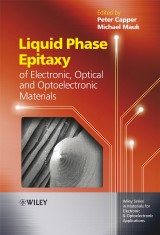Details

Liquid Phase Epitaxy of Electronic, Optical and Optoelectronic Materials
Wiley Series in Materials for Electronic & Optoelectronic Applications, Band 21 1. Aufl.
|
233,99 € |
|
| Verlag: | Wiley |
| Format: | |
| Veröffentl.: | 20.08.2007 |
| ISBN/EAN: | 9780470319499 |
| Sprache: | englisch |
| Anzahl Seiten: | 464 |
DRM-geschütztes eBook, Sie benötigen z.B. Adobe Digital Editions und eine Adobe ID zum Lesen.
Beschreibungen
Liquid-Phase Epitaxy (LPE) is a technique used in the bulk growth of crystals, typically in semiconductor manufacturing, whereby the crystal is grown from a rich solution of the semiconductor onto a substrate in layers, each of which is formed by supersaturation or cooling. At least 50% of growth in the optoelectronics area is currently focussed on LPE. <p>This book covers the bulk growth of semiconductors, i.e. silicon, gallium arsenide, cadmium mercury telluride, indium phosphide, indium antimonide, gallium nitride, cadmium zinc telluride, a range of wide-bandgap II-VI compounds, diamond and silicon carbide, and a wide range of oxides/fluorides (including sapphire and quartz) that are used in many industrial applications. A separate chapter is devoted to the fascinating field of growth in various forms of microgravity, an activity that is approximately 30-years old and which has revealed many interesting features, some of which have been very surprising to experimenters and theoreticians alike.</p> <ul> <li>Covers the most important materials within the field</li> <li>The contributors come from a wide variety of countries and include both academics and industrialists, to give a balanced treatment</li> <li>Builds-on an established series known in the community</li> <li>Highly pertinent to current and future developments in telecommunications and computer-processing industries.</li> </ul>
Series Preface. <p>Preface.</p> <p>Acknowledgements.</p> <p>List of Contributors.</p> <p>1. Introduction to Liquid Phase Epitaxy (Hans J. Scheel)</p> <p>2. Liquid Phase Epitaxy in Russia Prior to 1990 (V.A. Mishurnyi)</p> <p>3. Phase Diagrams and Modeling in Liquid Phase Epitaxy (Kazuo Nakajima)</p> <p>4. Equipment and Instrumentation for Liquid Phase Epitaxy (Michael G. Mauk and James B. McNeely)</p> <p>5. Silicon, Germanium and Silicon-Germanium Liquid Phase Epitaxy (Michael G. Mauk)</p> <p>6. Liquid Phase Epitaxy of Silicon Carbide (R. Yakimova and M. Syvajarvi)</p> <p>7. Liquid Phase Epitaxy of Gallium Nitride (Hans J. Scheel and Dennis Elwell)</p> <p>8. Liquid Phase Epitaxy of Quantum Wells and Quantum Dots (A. Krier, X.L. Huang and Z. Labadi)</p> <p>9. Liquid Phase Epitaxy of Hg<sub>1-x</sub> CD<sub>x</sub> Te (MCT) (P. Capper)</p> <p>10. Liquid Phase Epitaxy of Widegap II-VIs (J.F. Wang and M. Isshiki)</p> <p>11. Liquid Phase Epitaxy of Garnets (Taketoshi Hibiya and Peter Gornert)</p> <p>12. Liquid Phase Epitaxy: A Survey of Capabilities, Recent Developments and Specialized Applications (Michael G. Mauk)</p> <p>13. Liquid Phase Epitaxy for Light Emitting Diodes (Michael G. Mauk)</p> <p>Index.</p>
<p><b>Dr. Peter Capper</b> is a Materials Team Leader at BAE Systems Infrared Ltd., in Southampton, UK.</p> <p><b>Michael Mauk</b> is the editor of <i>Liquid Phase Epitaxy of Electronic, Optical and Optoelectronic Materials</i>, published by Wiley.</p>
Currently, some 60% of the multi-billion dollar optoelectronics industry is based on liquid phase epitaxially (LPE) grown material. LPE is a mature technology and has been used in the production of III-V compound semiconductor optoelectronic devices for some forty years. LPE has been applied to silicon, germanium, SiC, and II-VI and IV-VI compound semiconductors, as well as magnetic garnets, superconductors, ferroelectrics, and other optical materials. Many semiconductor devices including LEDs, laser diodes, infrared detectors, heterojunction bipolar transistors and heterointerface solar cells were pioneered with LPE. This is mainly due to the low costs that have been achieved with this technology, but also due to the very high quality of material produced, which often exceeds that possible by vapor phase epitaxies. <p>As the chapters in this book describe in detail, on-going efforts and new developments in LPE continue to widen its scope of applications and circumvent its customary limitations. The contents cover some introductory chapters, including an historical one on work in Russia prior to 1990, one on phase diagrams and modeling and one on equipment issues, before discussing the most important materials from silicon/silicon carbide, through the III-V and II-IV compounds to garnets, nitrides and a chapter on novel developments and one on LEDs. The contributors come from a wide variety of countries and include both academics and industrialists to give a balanced treatment.</p> <p><b>This book is mainly intended for postgraduate students to enable them to gain an insight into this extremely important area and specialist in the field both in academia and industry who will benefit from its wide-ranging and topical coverage of the subject.</b></p>


















